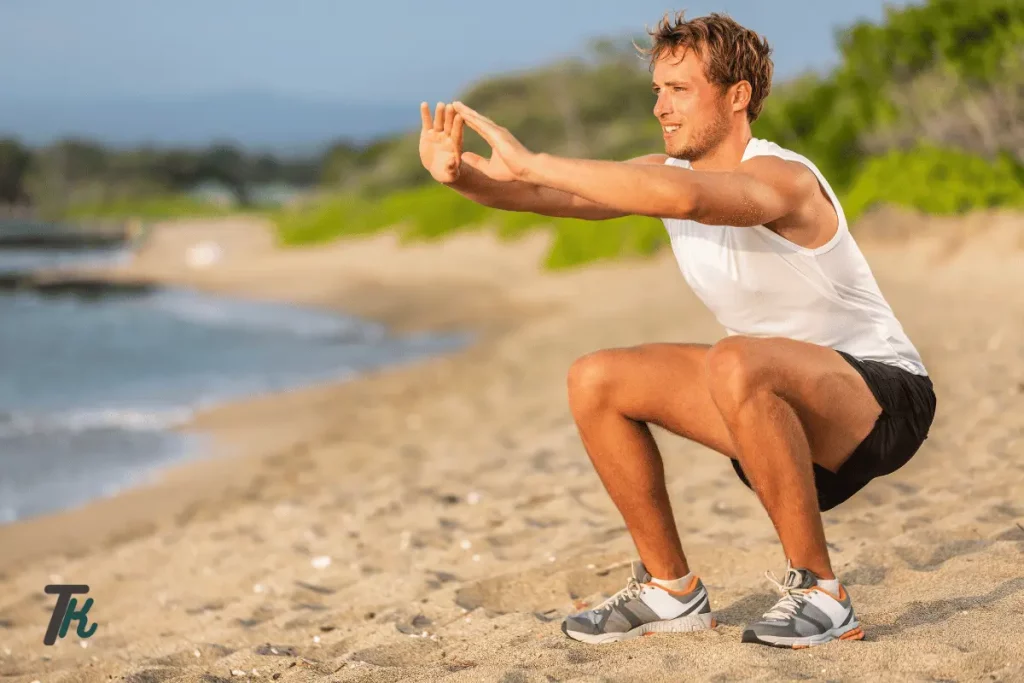As an Amazon Associate, I earn from qualifying purchases.
This article from the teamkathycarter website discusses about Heart pumping Exercise Routine That Might Include Jump Squats.
A heart-pumping exercise routine that might include jump squats is a high-intensity interval training (HIIT) workout. Jump squats are dynamic plyometric exercises that combine a squat with an explosive jump.
This exercise routine is beneficial for improving cardiovascular fitness, building lower body strength, and enhancing overall agility and power. Incorporating jump squats into a routine can help increase heart rate, burn calories, and improve muscular endurance. Additionally, it can add variety and intensity to a workout, making it an effective option for those looking to challenge themselves and elevate their fitness levels.
When performed with proper form and technique, jump squats can be a valuable addition to any heart-pumping exercise regimen.

Credit: www.lagreefit415.com
Benefits Of Heart Pumping Exercise Routine Jump Squats
Jump squats are an excellent addition to any heart-pumping exercise routine, offering a wide range of benefits that can enhance overall fitness and well-being. Incorporating jump squats into your workout not only elevates your heart rate but also yields numerous advantages for cardiovascular health and lower body strength. Let’s delve into the specific benefits of integrating jump squats into your exercise regimen.
Increased Cardiovascular Health- Heart Pumping Exercise Routine
Jump squats are an effective cardiovascular exercise that can significantly elevate your heart rate, enhancing blood circulation and boosting overall cardiovascular health. By engaging in this explosive movement, you stimulate the cardiovascular system, thereby promoting improved endurance and stamina.
Enhanced Lower Body Strength- Heart Pumping Exercise Routine
Engaging in jump squats leads to the development of lower body strength due to the dynamic nature of the movement. This exercise targets the quadriceps, hamstrings, glutes, and calves, effectively strengthening these major muscle groups. Consequently, it contributes to improved stability, agility, and power in the lower body.
Proper Form And Technique- Heart Pumping Exercise Routine
Proper Form and Technique are crucial to performing jump squats effectively and efficiently. Focusing on the subheadings of Foot Positioning and Depth of Squat, let’s delve into the specifics of executing this heart-pumping exercise routine with precision.
Foot Positioning- Heart Pumping Exercise Routine
Positioning your feet correctly is the foundation of a successful jump squat. Start by standing with your feet shoulder-width apart. Point your toes slightly outward, ensuring they are parallel with each other and the direction you want to move.
Depth Of Squat- Heart Pumping Exercise Routine
The depth of your squat is essential for engaging the proper muscles and maximizing the exercise’s benefits. Bend your knees and lower your hips until your thighs are parallel to the ground.
Ensure that you maintain an upright posture throughout the movement. Keep your chest lifted, shoulders relaxed, and core engaged. Avoid rounding your back or leaning forward excessively.
Remember, as you descend into the squat position, keep your weight centered on your heels. This will help you maintain balance and prevent undue strain on your knees.
Common Mistakes To Avoid- Heart Pumping Exercise Routine
- Avoid allowing your knees to extend over your toes during the squat. This could put unnecessary stress on your knees and increase the risk of injury.
- Avoid bouncing or using momentum to jump back up. Instead, focus on using the power of your leg muscles to explode into the air.
- Avoid rushing through the exercise. Ensure that you maintain control and perform each repetition with deliberate intent and proper form.
Jump squats offer numerous benefits for cardiovascular fitness, lower body strength, and explosive power. Incorporating jump squats into your exercise routine can:
- Improve lower body muscle strength, including the quadriceps, hamstrings, and glutes.
- Enhance explosiveness and power, which translates to improved athletic performance.
- Engage the core muscles, leading to improved stability and posture.
- Burn calories and increase cardiovascular endurance, promoting overall fitness.
Remember to consult with a fitness professional or trainer before incorporating jump squats or any new exercise into your routine. They can guide you on the proper form and offer modifications if needed. Now that you understand the proper form and technique of jump squats, it’s time to put it into practice and experience the exhilarating benefits for yourself!
Variations To Spice Up Your Routine- Heart Pumping Exercise Routine
When it comes to adding some excitement to your exercise routine, incorporating variations is key. One way to do this is by including different types of jump squats. These heart-pumping exercises not only target your lower body muscles but also improve your cardiovascular endurance. In this article, we will explore two variations of jump squats that you can try to power up your workout.
Plyometric Jump Squats- Heart Pumping Exercise Routine
If you are looking for an explosive and challenging exercise, plyometric jump squats are perfect for you. This variation involves adding an extra jump at the end of each squat repetition, pushing your muscles to work harder and faster. By engaging your fast-twitch muscle fibers, plyometric jump squats can help improve your power and agility. Here’s how to perform this exercise:
- Start by standing with your feet shoulder-width apart, toes pointing forward.
- Lower down into a squat position, keeping your back straight and chest lifted.
- Explode up from the squat, using your leg muscles to propel yourself off the ground.
- While in the air, tuck your knees towards your chest.
- Land softly and immediately go into the next squat repetition.
- Repeat for 10-15 reps, or as many as you can with proper form.
Weighted Jump Squats- Heart Pumping Exercise Routine
Adding weights to your jump squats can take the intensity up a notch, challenging your muscles in new ways. This variation helps build strength, as well as boost your calorie burn. Here’s how to perform weighted jump squats:
- Hold a dumbbell or kettlebell in each hand, resting them at your sides.
- Stand with your feet hip-width apart, toes facing forward.
- Lower down into a squat position, keeping your back straight and core engaged.
- From the squat, explode up and push through your legs to jump off the ground.
- As you jump, press the weights overhead, extending your arms fully.
- Land softly and immediately go into the next squat repetition.
- Repeat for 10-15 reps, or as many as you can with proper form.
By incorporating these variations into your routine, you can keep your workouts exciting and challenging. Remember to start slow and gradually increase the difficulty as you become more comfortable. Adding plyometric jump squats and weighted jump squats to your exercise regimen can take your fitness goals to new heights.
Incorporating Jump Squats Into Your Workout
Jump squats are a dynamic and effective exercise that can add a new dimension to your workout routine. Incorporating jump squats into your workout can help elevate your heart rate, build strength, and improve overall athleticism. Whether you are a beginner or a seasoned fitness enthusiast, there are various ways to integrate jump squats into your routine to maximize their benefits. Here are a few strategies for incorporating jump squats into your workout:
Warm-up With Jump Squats
Before diving into your main workout, consider using jump squats as part of your warm-up routine. Jump squats can help activate the muscles in your lower body, increase your heart rate, and prepare your body for more intense exercises. By adding jump squats to your warm-up, you can enhance your overall performance during the main workout session. Perform a set of 10-15 jump squats, focusing on proper form and controlled movements, to effectively prime your body for the workout ahead.
Circuit Training With Jump Squats
Incorporating jump squats into a circuit training routine can add an element of power and explosiveness to your workout. Include jump squats as one of the exercises in a circuit, alternating with other strength or cardio movements. For example, you can create a circuit that includes bodyweight squats, push-ups, and jump squats. Perform each exercise for a set amount of time or repetitions, and then move on to the next without resting in between. This style of training can help elevate your heart rate, improve endurance, and boost overall cardiovascular fitness.
Avoiding Common Mistakes- Heart Pumping Exercise Routine
It’s crucial to perform jump squats correctly to prevent injuries and maximize effectiveness.
Incorrect Landing- Heart Pumping Exercise Routine
Landing too heavily during jump squats can strain your joints, especially the knees. Avoid this by landing softly with knees slightly bent.
Hyperextending The Knees- Heart Pumping Exercise Routine
Avoid straightening your knees completely when jumping up, as this can put undue stress on the knee joints.
Benefits Of Adding Explosive Movements- Heart Pumping Exercise Routine
Explosive movements, such as jump squats, have numerous benefits that can elevate your workout routine. These movements not only challenge your muscles but also provide a variety of advantages, including improving agility and coordination, enhancing power and strength, and boosting cardiovascular endurance.
Boosting Explosive Power- Heart Pumping Exercise Routine
Explosive movements like jump squats activate fast-twitch muscle fibers, aiding in developing strength and power rapidly. Incorporating these dynamic exercises can enhance your overall explosiveness and athleticism.
Increasing Caloric Burn
By engaging in explosive movements during your workout, such as jump squats, you can elevate your heart rate, leading to a significant increase in calorie expenditure. This can contribute to more effective fat burning and weight management.
Integration With Other Exercises
Integrating jump squats into a comprehensive exercise routine can optimize your workout, maximizing the benefits for your lower body while also enhancing cardiovascular endurance. Adding different exercises to your routine allows you to target multiple muscle groups, requiring coordination and flexibility, resulting in a well-rounded and effective workout.
Combining With Burpees
Combining jump squats with burpees creates an intense full-body workout. Start with 10 jump squats followed by 10 burpees, then repeat for three sets. This combination engages the lower body with jump squats and demands explosive total-body movement with burpees, resulting in a high-energy cardio and strength workout.
Pairing With Lunges
Pairing jump squats with lunges can be an effective way to supercharge your lower body workout. Begin with 10 jump squats, then transition into 10 lunges on each leg, and repeat for three sets. This combination not only targets the quadriceps, hamstrings, and glutes but also helps improve stability and balance.
Safety Precautions And Considerations
Prior to engaging in a heart-pumping exercise routine that may involve jump squats, it is crucial to prioritize safety precautions and considerations. Ensure proper warm-up, form, and gradually increase intensity to prevent injury and optimize results. It’s essential to listen to your body and consult a fitness professional if needed.
Consulting With A Trainer
When it comes to incorporating heart-pumping exercises like jump squats into your routine, it is important to prioritize safety precautions and considerations. One of the best ways to ensure you are performing these exercises correctly and minimizing the risk of injury is by consulting with a certified fitness trainer. A trainer can assess your fitness level, provide personalized guidance, and help you design an exercise routine that suits your needs and goals. Whether you are a beginner or have been exercising for a while, a trainer can offer valuable insights and prevent you from making common mistakes.
Listening To Your Body
Listening to your body is essential when engaging in any kind of exercise, including jump squats. Our bodies have an incredible way of communicating with us, and learning to tune into these signals is crucial for injury prevention. As you perform jump squats or any other high-intensity exercise, pay attention to any discomfort or pain. If you experience sharp or sudden pain, it is important to stop the exercise immediately and consult with a healthcare professional. Additionally, be mindful of any cues from your body indicating fatigue or muscle exhaustion. Pushing yourself too hard without proper rest can lead to burnout and potential injuries.
Proper Warm-up And Cool-down
Including a proper warm-up and cool-down in your exercise routine is vital for safeguarding your body from potential injuries. Before you jump into jump squats or any other intense activity, spend a few minutes getting your body prepared. This could involve a range of dynamic stretching exercises, such as leg swings, hip circles, and arm circles. These movements help increase blood circulation, warm up your muscles, and enhance flexibility, making them less prone to strains or tears. Similarly, after you have completed your exercise session, take the time for a cool-down period that allows your heart rate and breathing to gradually return to normal. This can be achieved through simple static stretches or gentle walking.
The Importance Of Proper Form
When performing jump squats, maintaining proper form is crucial for both safety and effectiveness. Start by standing with your feet shoulder-width apart and your toes pointing slightly outwards. Bend your knees and hips to lower into a squat position, ensuring that your knees align with your toes and your weight is evenly distributed on both feet. As you come up from the squat, explode off the ground using your leg muscles while keeping your core engaged. Land softly, with bent knees, and immediately go into the next squat. Remember, the quality of each squat is more important than the quantity, so avoid rushing through the exercise and prioritize correct form to maximize results while minimizing the risk of injury.
Gradual Progression And Rest Days
When incorporating jump squats or any other intense exercise into your routine, it is crucial to progress gradually and give your body adequate rest days. Gradual progression allows your muscles, tendons, and ligaments to adapt to the increased demands of exercising. This means starting with a comfortable number of reps and sets and gradually increasing them over time. Aim to add only a moderate increase to the intensity or volume of your exercises each week to avoid overexertion. Additionally, make sure to schedule rest days in your routine to give your body time to recover and repair itself. Rest allows your muscles to grow stronger and helps prevent overuse injuries that can occur from excessive training.
By following these safety precautions and considerations, you can confidently incorporate jump squats or any other intense exercise into your routine. Remember, consulting with a trainer, listening to your body, practicing proper form, and allowing for gradual progression and rest days are all essential for a safe and effective workout experience. Stay mindful of your body’s signals and never hesitate to seek professional guidance if needed, ultimately prioritizing your physical well-being and optimizing your fitness journey.
:upscale()/2014/01/10/048/n/1922729/30499ae6b8e1714a_jumpsquat.jpg)
Credit: www.popsugar.com
Frequently Asked Questions
Can I Lose Weight With A Heart-pumping Exercise Routine?
Yes, a heart-pumping exercise routine, such as one that includes jump squats, can help you lose weight. These intense exercises burn calories and increase your heart rate, promoting fat loss and improving overall fitness levels.
Are Jump Squats Effective For Toning My Leg Muscles?
Absolutely! Jump squats, as part of a heart-pumping exercise routine, can be highly effective for toning your leg muscles. They target multiple muscle groups, including the quadriceps, hamstrings, and glutes, helping to strengthen and sculpt your lower body.
Is It Important To Warm Up Before Doing Jump Squats?
Yes, warming up is crucial before performing jump squats or any other intense exercise. It helps increase blood flow, prepare muscles and joints, and reduce the risk of injury. To warm up effectively, incorporate dynamic stretches, such as leg swings and lunges.
How Many Jump Squats Should I Do In A Heart-pumping Routine?
The number of jump squats you should do in a heart-pumping exercise routine depends on your fitness level and goals. Start with a manageable amount, such as 10 to 15 repetitions, and gradually increase as your strength and endurance improve.
Conclusion
Incorporating jump squats into your exercise routine can significantly increase heart rate and improve lower body strength. Remember to warm up before starting any high-intensity exercises to avoid injury. Consistency is key to reaping the benefits of this challenging but effective workout.
Stay motivated and keep pushing your limits for a healthier lifestyle.
As an Amazon Associate, I earn from qualifying purchases.




